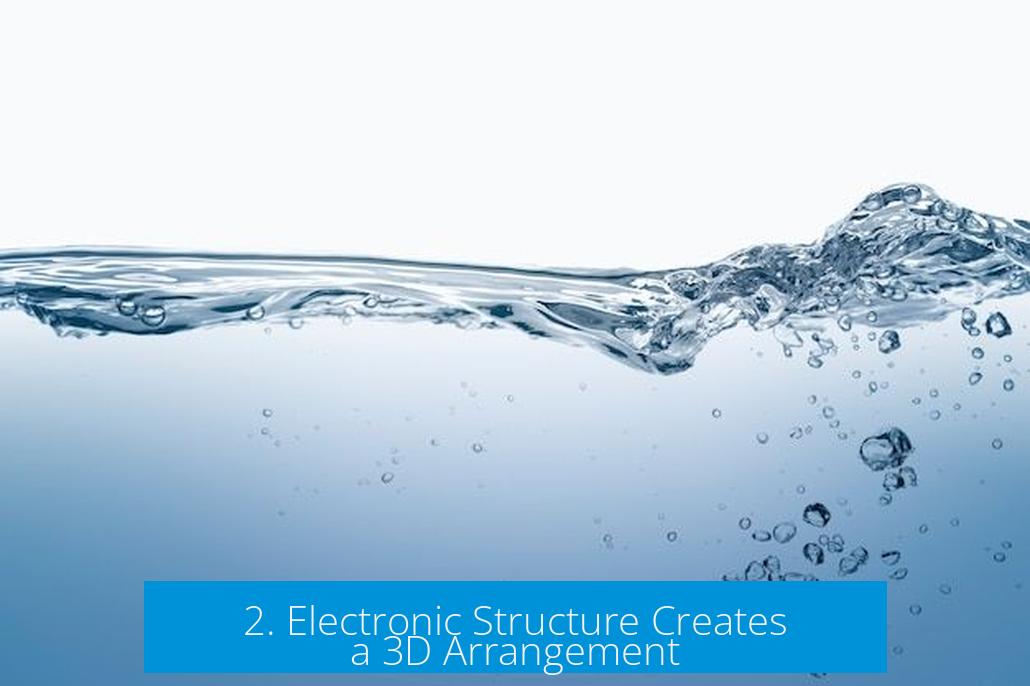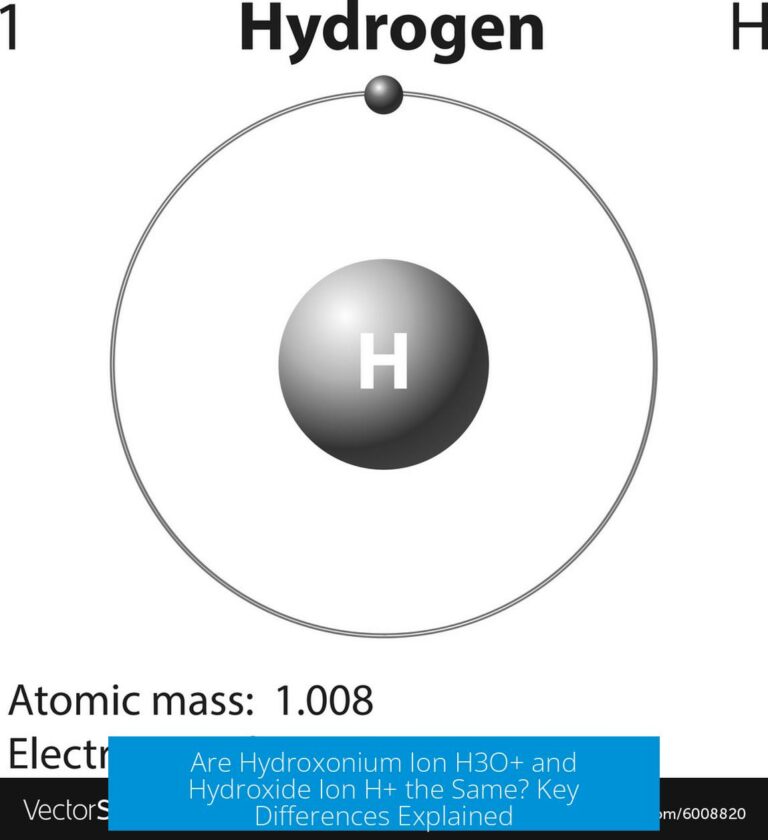Are Water Molecules 2-D or 3-D?

Water molecules are fundamentally three-dimensional (3D) in nature, considering their electron distribution and physical volume. However, if focusing strictly on the positions of the atomic nuclei (oxygen and the two hydrogens), these lie in a single plane, making the molecular geometry appear two-dimensional (2D). This duality arises from the distinction between atomic positioning and electronic structure, as well as the perspectives used for molecular modeling.
1. Atomic Arrangement: Geometric Plane of Nuclei
Water consists of three atoms: one oxygen and two hydrogen atoms. From a pure mathematical standpoint, any three points define a unique geometric plane. Therefore, the nuclei of these atoms lie flat in a 2D plane. This planar arrangement is a simple geometric reality.
The bond angle between the hydrogen atoms in water is approximately 104.5°, creating a bent or V-shaped structure. This angle and arrangement mean the oxygen and hydrogen nuclei define a plane—thus, the atomic framework is 2D.
2. Electronic Structure Creates a 3D Arrangement

The pure 2D perspective changes when electron pairs around the oxygen atom are considered. Oxygen holds four regions of electron density: two bonding pairs (shared with hydrogens) and two lone pairs (unshared). These electron pairs repel each other to minimize repulsion, adopting a tetrahedral orientation. This electron geometry places these pairs in three-dimensional space.
Because lone pairs influence molecular shape, the overall molecular geometry deviates from a perfect tetrahedron to a bent shape. The presence of lone pairs also slightly compresses the H–O–H angle compared to an ideal tetrahedron (109.5°).
- The electron pairs form a 3D tetrahedral electronic geometry.
- The atomic nuclei lie in a 2D plane.
- The molecular geometry is bent or V-shaped, reflecting the tetrahedral electron pair placement.
This distinction reveals that the molecular geometry defined by nuclei positions appears flat, but the electron clouds and bonding environment give water a genuine 3D character.
3. Visualization: 2D vs 3D Models
Molecular models vary depending on which components they emphasize:
- Nuclei-only models: Represent atoms as points or spheres positioned in a plane. They simplify water as a 2D shape, useful for basic structural understanding.
- Electron density models: Visualize electron clouds or bonding orbitals, which are inherently 3D. These depict water’s tetrahedral electronic geometry and spatial electron repulsions.
When electron pairs are included, visualization tools depict water as a 3D molecule. Even the simplest molecule occupies volume in space due to electron cloud distributions around atoms.
4. Molecular Shape and VSEPR Theory

Valence Shell Electron Pair Repulsion (VSEPR) theory explains water’s shape:
- AXE notation: In this method, “A” stands for the central atom (oxygen), “X” for bonded atoms (two hydrogens), and “E” for lone pairs (two on oxygen).
- The AX2E2 configuration leads to a bent shape because lone pairs repel bonded atoms more strongly.
- This arrangement creates a 3D molecular shape that differs from the purely planar atomic positions.
This bent geometry is crucial for water’s unique properties, such as its polarity and hydrogen bonding behavior.
5. Physical Reality: 3D Volume and Atomic Thickness
Beyond theoretical models, water molecules exist as tangible objects occupying three-dimensional space. Each atom has size, electron clouds have extent, and the molecule occupies volume.
Atoms are not dimensionless—they have finite radii, and electrons move in orbitals extending in eight directions around oxygen. This ensures water molecules possess 3D spatial volume.
Therefore, no matter how flat a 2D representation looks on paper or a screen, the physical molecule is inherently 3D.
6. Time and Molecular Dynamics Influence Dimensionality

At any given instant, the nuclei of water atoms lie in a plane. However, molecular vibrations cause continual fluctuations in bond angles and atomic positions.
These dynamic movements push the atoms slightly out of a fixed plane. Over time, this results in a 3D kinetic behavior. Freezing time reveals a 2D snapshot of nuclei, but considering molecular dynamics shows a fluctuating 3D molecular environment.
7. Summary Table of Dimensionality Perspectives
| Aspect | Dimensionality | Explanation |
|---|---|---|
| Atomic nuclei arrangement | 2D (planar) | Three nuclei always lie in a geometric plane. |
| Electronic structure (electron pairs) | 3D (tetrahedral) | Electron density regions orient in three dimensions to minimize repulsion. |
| Molecular geometry | 3D (bent shape) | Lone pairs cause non-linear angles and 3D shape despite planar nuclei. |
| Physical molecule in space | 3D | Atoms occupy volume, electrons extend in space, and molecule is tangible. |
| Visualization | 2D or 3D depending on model | Nuclei-only drawings are planar; electron cloud models show 3D geometry. |
| Molecular dynamics | Time-dependent 3D | Atomic vibrations cause displacement out of plane over time. |
8. Conclusion: Interpretations Depend on Perspective
Water’s dimensionality depends on the focus of analysis:
- From a pure atomic nuclei position view, water is 2D because the three atoms lie on a plane.
- Considering electron pairs and their repulsions, water is 3D, exhibiting tetrahedral electron geometry and bent molecular shape.
- Physical molecules exist in 3D space with finite volume and dynamic motion.
Scientists and educators use both simplified 2D and detailed 3D models depending on the application. This flexibility clarifies fundamental chemistry while respecting physical reality.
Key Takeaways
- Water molecule atomic nuclei always lie in a single plane (2D configuration).
- Electron pairs around oxygen adopt a tetrahedral arrangement, creating 3D electron geometry.
- The molecular shape of water is bent (V-shaped) due to lone pair repulsions.
- Visual models depict water as 2D or 3D depending on nuclei versus electron cloud considerations.
- Physical water molecules occupy 3D space with atomic thickness and dynamic motion.
- Molecular vibrations cause time-dependent deviations from planarity, emphasizing 3D nature.
Are Water Molecules 2-D or 3-D? Unpacking the Molecular Mystery
Are water molecules 2-D or 3-D? The short answer: They are both, depending on how you look at them. This dual identity might sound like a sci-fi twist, but it reflects the fascinating complexity of molecular structure. Let’s dive into why this tiny trio—two hydrogens and one oxygen—can’t decide if it’s flat or three-dimensional.
At first glance, water’s structure might seem simple. After all, it’s just H2O—two hydrogens attached to an oxygen atom. But the story is richer when you peek into the arrangement of atoms and electrons, and even the way this molecule dances through space over time.
Water’s Atomic Positions: The Case for 2D
Picture this: A triangle always fits on a flat sheet of paper. That’s fundamental math right there. The atomic nuclei of water—oxygen and the two hydrogens—are three points. No matter how you twist or turn it, these three points lie on the same plane.
What does that mean? In terms of the nuclei’s geometric positions, water is 2D. You can imagine drawing the H–O–H structure perfectly on a piece of paper without any atoms lifting off. That’s the plain and simple skeleton, the dots-and-lines version of the molecule.
But wait, water doesn’t just sit motionless on the paper. These nuclei jiggle and vibrate. Freeze time—a snapshot—and yes, nuclei are 2D. Watch them in motion, and they shift slightly into three-dimensional space. Suddenly, what was flat transforms into a subtle 3D dance.
Electrons Bring the Third Dimension: Beyond the Plane
Now, if you zoom in beyond the nuclei, electrons enter the spotlight. Especially the oxygen atom, with its ‘p-orbitals’ buzzing around. These orbital clouds don’t play by flat rules. Instead, they spread out in three dimensions, like invisible bubbles seeking the most space possible.
This electron cloud shapes the molecule’s electronic geometry. While the nuclei are stuck in a triangle on the page, electrons arrange themselves in a tetrahedral pattern. For the water molecule, this means two lone pairs of electrons and two O–H bonds spread out to form a pseudo-tetrahedral geometry.
That’s a fancy way of saying water’s shape isn’t just a flat “V”—it pokes out in 3D space. These lone electron pairs push the bonded hydrogens down, giving water its well-known bent, V-shaped structure.
Why Does Molecular Shape Matter? The Bent Geometry Explained
Water’s bent molecular shape springs from the Valence Shell Electron Pair Repulsion (VSEPR) theory. In this model, electrons, especially non-bonded lone pairs, repel each other. The AXE method (A = central atom, X = bonded atoms, E = lone pairs) labels water as AX2E2.
Two lone pairs on oxygen push the hydrogens closer together. The result: an angle of about 104.5°, not the 109.5° you’d expect for a perfect tetrahedron. This arrangement happens in three-dimensional space—it can’t be squished down properly onto a flat plane without distortion.
Is It Just a Model? The Physical Realities of Water Molecules
We often see molecules drawn in 2D on paper or screens. These representations serve as study tools, but they don’t perfectly capture reality. Physically, molecules occupy space with atoms having actual size and electron clouds swirling about.
Here’s the kicker: The physical water molecule is never just 2D. It has volume. Think about the thickness of oxygen’s electron cloud, the subtle movement caused by molecular vibrations, and the three axes of real space. These factors anchor water firmly into the 3D realm.
Even atoms aren’t just points—they have size and thickness. So in the real world, nothing molecule-shaped fits flat on a plane like a sticker. This reflects the world’s natural three-dimensionality.
Drawing Water Molecules: Tricks of the Trade
Visualizing molecules is a challenge. Chemists use various tricks to portray 3D structures on 2D surfaces. Wedges and dashed lines indicate bonds going in and out of the plane. Colors represent different atoms.
For more complex molecules, like glucose or DNA, these drawings become puzzles. Water’s simplicity makes it easier: You can sketch water flat in 2D for quick understanding, but never forget it truly exists in 3D space.
Dynamic Dimensions: Time and Molecular Vibrations
Water molecules aren’t static sculptures. They vibrate, bend, and twist due to thermal energy. These vibrational modes shift nuclei positions slightly out of the plane.
Think of it like a ballet dancer spinning. For a single frame, you see a silhouette (2D). For the entire dance, the movements flow through space in all directions (3D). Water’s nuclei waltz dynamically, from planar to fully 3D shapes over time.
This time-dependent behavior means dimensionality is fluid, depending on the snapshot or the cinematic view you take.
Summary: The Best of Both Worlds
So, where does this leave us? Water molecules wear two hats. Their atomic nuclei form a neat, planar triangle—a solid 2D structure. Electrons orbit in three-dimensional space, dictating a bent, pseudo-tetrahedral molecular shape. The molecule’s physical presence and dynamic vibrations anchor it in the 3D world.
| Aspect | Dimensionality | Key Point |
|---|---|---|
| Atomic nuclei positions | 2D | Triangular nuclei layout fit on a plane |
| Electron pair geometry | 3D | Tetrahedral distribution of lone and bonded pairs |
| Molecular shape | 3D | Bent/V-shaped due to lone pairs repulsion |
| Physical volume | 3D | Molecules occupy actual volume in space |
| Visualization techniques | 2D | Flat drawings for study and simplicity |
| Vibrational dynamics | Time-dependent | Movement shifts structure beyond fixed plane |
Wrapping Up – So, Is Water Molecule 2D or 3D?
The dimensional identity depends on what you examine. If you focus only on the atomic nuclei frozen in one moment, water looks flat—2D. If you include electrons, physical size, and time’s unfolding movement, water unfolds as a dynamic, three-dimensional marvel.
In short, the water molecule is a master of disguise. It can be the “flat friend” in your chemistry sketchbook or the “voluminous diva” in reality. Understanding both perspectives sharpens your insight into molecular science and reminds us why chemistry is both logical and surprisingly poetic.
Next time you take a sip of water, think about this shape-shifting molecule quietly breaking the 2D/3D barrier right in your glass!
1. Are water molecules fundamentally 2D or 3D based on their atomic positions?
The nuclei of the three atoms (two hydrogens and one oxygen) lie in a single plane, making their atomic positions effectively 2D. Three points always fit on a flat surface.
2. Why is the electronic structure of water considered 3D?
Oxygen’s electron pairs, including lone pairs, arrange tetrahedrally to maximize space. This electron distribution forms a 3D shape, unlike the planar nuclei arrangement.
3. How does including electron pairs affect the water molecule’s dimensionality in models?
If the model shows only atomic nuclei, water can be seen as 2D. When electron pairs are included, the geometry becomes tetrahedral and 3D.
4. Does the water molecule’s vibration change its dimensional classification?
Over time, vibrations cause the nuclei to move out of a fixed plane, showing a 3D aspect dynamically. A static view appears 2D, but dynamics reveal 3D behavior.
5. Can water be accurately represented in 2D drawings despite its 3D nature?
Yes, water is often drawn flat for simplicity. However, physically it occupies 3D space because atoms have size and electron clouds span three dimensions.





Leave a Comment